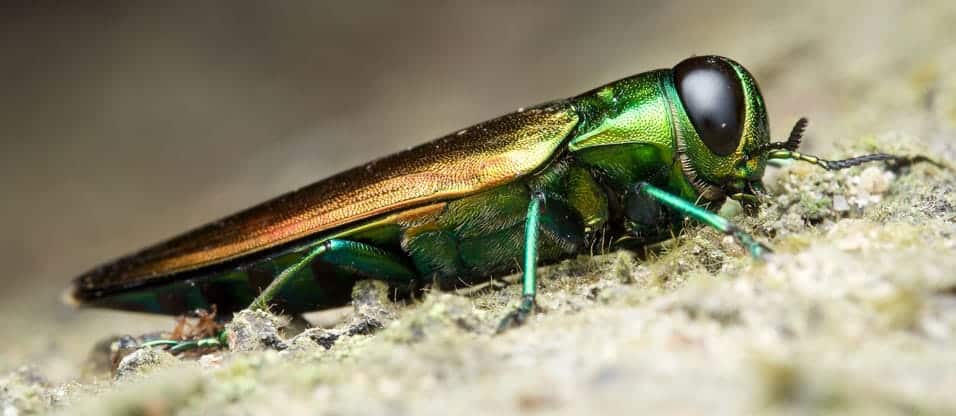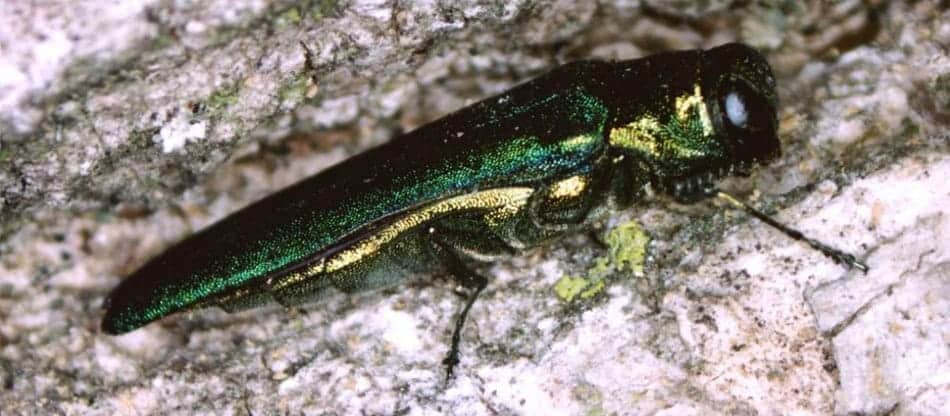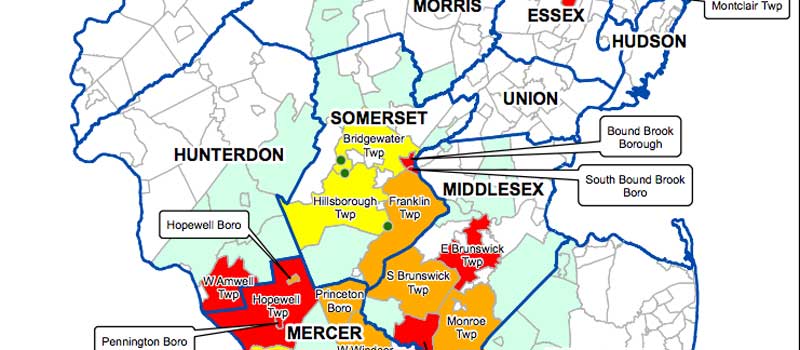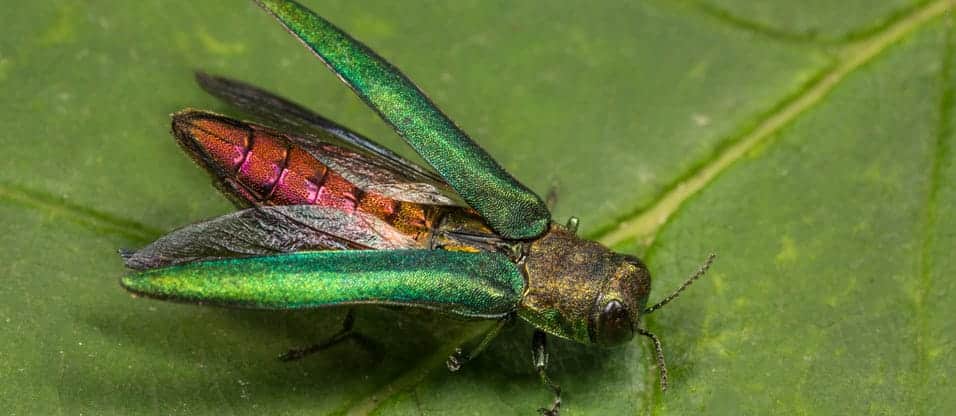Emerald Ash Borer
Identification, Prevention & Treatment Options
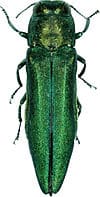
The Emerald Ash Borer (EAB) is now one of the most destructive non-native insects in the United States.
Cost estimates of dealing with dead ash trees over the next decade in the U.S. will exceed 10 billion dollars in urban settings alone.
Emerald Ash Borer has been present in New Jersey since 2014 and has spread throughout most of the state.
Without treatment, ash trees WILL die within a few years.
Take Action Now to Protect your Important Ash Trees
Not Sure If You Have Ash Trees??
Call us at 908-309-6611
Speak with one of our Licensed Tree Experts
We'll help you identify any ash trees on your property, advise you on which trees are worth treating, and provide a free estimate on treatment options.
Cost-effective EAB treatments ARE available to protect individual ash trees, but must be started early.
Doing nothing is no longer an option.
What You Need To Know About EAB
Is EAB Really All That Serious?
Since its accidental introduction into the United States and Canada in the 1990s and its subsequent detection in 2002, emerald ash borer has spread to 15 states and adjacent parts of Canada. It has killed at least 100 million ash trees so far and threatens to kill most of the 8.7 billion ash trees throughout North America.
Estimates for New Jersey alone are that EAB will cause upwards of $2.7 billion in damage, kill almost all ash trees and depress property values across the state.
For details, including information on how OPC treats ash trees for EAB, see our Emerald Ash Borer FAQs.
Healthy ash trees in 2006 before EAB damage
The same ash trees after EAB damage in 2009
Are YOUR Ash Trees At Risk?
Because symptoms are difficult to see during the first 1-2 years of infestation, if you live in any of the areas shown below, we recommend that you consult with a certified tree expert or arborist immediately to evaluate your important ash trees.
Where Has Emerald Ash Borer Been Found In New Jersey?
As of March 2019, emerald ash borer has been positively identified in New Jersey in Bergen, Burlington, Camden, Essex, Hudson, Hunterdon, Mercer, Middlesex, Monmouth, Morris, Passaic, Somerset, Sussex and Warren counties, although it's probably present across the entire state.

Map from State of New Jersey Department of Agriculture [http://www.nj.gov/agriculture/divisions/pi/prog/emeraldashborer.html]
Where Has Emerald Ash Borer Been Found In Pennsylvania?
As of the end of 2018, EAB has been identified in all 67 counties in Pennsylvania.
How to Tell if Your Ash Trees Have Been Attacked by EAB
The symptoms an ash tree shows when it is infested with emerald ash borer can be similar to symptoms caused by other ash pests or diseases. Crown dieback, for example, could be from EAB damage, or be the result of drought stress, soil compaction or verticillium wilt, to name a few.
Typically in the third year after infestation, the tree will exhibit significant dieback. At that point, treatment options will not be effective. By the end of the 4th year, the tree will likely be dead.
After that, dead ash trees become brittle and potentially hazardous, often dropping major limbs. Because the volume of trees that die at one time is often so large, cities and homeowner groups are being caught unprepared and often unable to remove the trees because of the lack of resources, as well as available tree removal services. As a result, neighborhoods are left with an unsightly and dangerous situation.
You should immediately suspect EAB if you observe at least two of the symptoms or signs below.
Symptoms of EAB Infestation
- Crown dieback: Dieback of the upper and outer crown begins after multiple years of EAB larval feeding. Trees start to show dead branches throughout the canopy, beginning at the top. Larval feeding disrupts nutrient and water flow to the upper canopy, resulting in leaf loss. Leaves at the top of the tree may be thin and discolored.
- Epicormic Sprouting: When trees are stressed or sick, they will try to grow new branches and leaves wherever they still can. Trees may have new growth at the base of the tree and on the trunk, often just below where the larvae are feeding.
- Bark splits: Vertical splits in the bark are caused due to callus tissue that develops around larval galleries. Larval galleries can often be seen beneath bark splits.
- Woodpecker feeding: Woodpeckers eat emerald ash borer larvae that are under the bark. This usually happens higher in the tree where the emerald ash borer prefers to attack first. If there are large numbers of larvae under the bark the woodpecker damage can make it look like strips of bark have been pulled off of the tree. This is called "flecking."
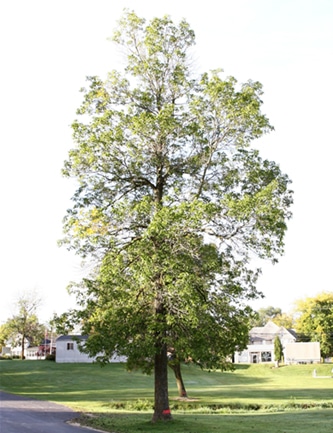
Signs of EAB Infestation
- D-shaped emergence holes: As adults emerge from under the bark they create a D-shaped emergence hole that is about 1/8 inch in diameter.
- S-shaped larval galleries: As larvae feed under the bark they wind back and forth, creating galleries that are packed with frass (larva poop) and sawdust and follow a serpentine pattern.
- Larvae: Larvae are cream-colored, slightly flattened and have pincher-like appendages at the end of their abdomen. By the time larvae are done growing they are 1 1/2 inches long. Larvae are found feeding beneath the bark.
- Adults: Adult beetles are metallic green and about the size of one grain of cooked rice (3/8 - 1/2 inch long and 1/16 inch wide). Adults are flat on the back and rounded on their underside.
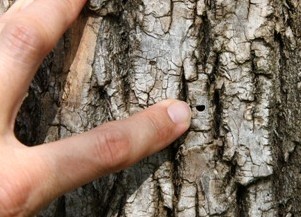
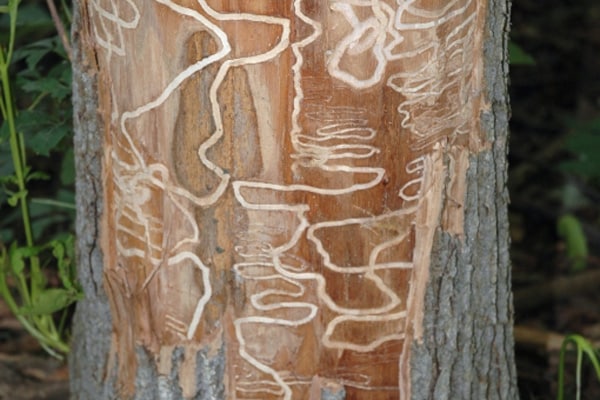
EAB Prevention & Treatment
Prevention is the Best Medicine
As with most disease and insect damage, prevention is the best medicine. Systemic applications injected into the trunk of the tree have proven to be the most effective method of protecting individual, as well as stands of, high-value ash trees. At Organic Plant Care, we use an injectable azadirachtin-based insecticide created from extracts of Neem tree seeds. Systemic injection into the tree's vascular system allows the insecticide to quickly translocate throughout the tree.
Treatment Options
While there are several systemic insecticides approved to control EAB, azadirachtin is the most environmentally acceptable. It works by disrupting the insects' growth and molting ability, as well as significantly reducing egg-laying and viability. Studies show that other products pose a risk of harm to pollinators and aquatic and soil organisms since it is expressed through pollen and still present in the leaves when they're shed in the fall.
>> For more information on treatment options, see our Emerald Ash Borer Treatment fact sheet.
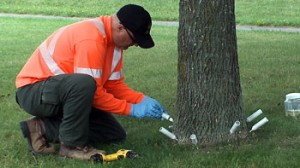
TreeAzin systemic trunk injection
Other control methods include soil drench, soil injection or foliar/trunk sprays which must be done annually and are usually only effective at the beginning of an infestation and on smaller ash trees under 12-15".
Effective treatment depends on pest levels, tree health, the products being used and proper application. Often, an infested tree will continue to show some canopy decline the first year after being treated, but then begin to improve the second year as it begins to recover.
Once an ash tree exhibits more than 50% canopy dieback or thinning it is unlikely to recover even if treated with a highly effective systemic insecticide. At that point, the best option is removal of the tree.
Treatment Timing
Treatment applications should be done from early May through the end of August to target emerging foliar-feeding adult EAB beetles and younger larvae feeding under the bark on the cambium layer of the tree. Trunk injections provide up to 2 years of protection against EAB, depending on the population of the pest in the local area. The organic treatment OPC uses, TreeAzin, must be reapplied every one to two years until EAB populations begin to decline.
It's Up To You
The decision to invest in protecting your ash trees is an important one and should be discussed with a knowledgeable, certified arborist. Mature ash trees add beauty and grace to a landscape and provide numerous other benefits.
Contact us today or call 908-309-6611. We'll evaluate your ash trees and give you a complimentary estimate for treatment or removal.
Complimentary EAB Treatment Quote
Click to schedule an inspection of your ash trees or give us a call at 908-309-6611.

